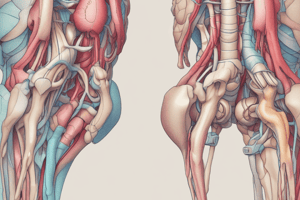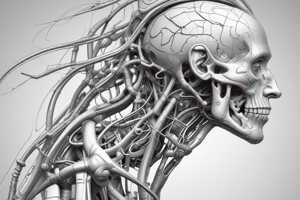Podcast
Questions and Answers
What type of joint is the atlanto-axial joint?
What type of joint is the atlanto-axial joint?
- Ball & Socket
- Hinge
- Pivot (correct)
- Saddle
What is the primary function of the synovial membrane?
What is the primary function of the synovial membrane?
- To secrete synovial fluid and bring nutrients to articular cartilage (correct)
- To surround the joint and hold the bones together
- To thicken the fibrous capsule of the joint
- To reduce friction in the joint
Which type of joint has a rounded surface of one bone that articulates with a ring formed by a second bone and a ligament?
Which type of joint has a rounded surface of one bone that articulates with a ring formed by a second bone and a ligament?
- Ball & Socket
- Hinge
- Pivot (correct)
- Saddle
What is the main purpose of the endomysium?
What is the main purpose of the endomysium?
What is the function of the T-tubules in muscle cells?
What is the function of the T-tubules in muscle cells?
What is the ability of muscles to respond to chemicals released from nerve cells?
What is the ability of muscles to respond to chemicals released from nerve cells?
What type of joint has a convex surface of one bone that fits into a concave surface of another bone?
What type of joint has a convex surface of one bone that fits into a concave surface of another bone?
What is the role of the sarcoplasmic reticulum in muscle cells?
What is the role of the sarcoplasmic reticulum in muscle cells?
What is the primary function of the articular cartilage in synovial joints?
What is the primary function of the articular cartilage in synovial joints?
Which type of synovial joint allows for rotation, flexion, extension, abduction, and adduction?
Which type of synovial joint allows for rotation, flexion, extension, abduction, and adduction?
What is the function of the epimysium in muscle tissue?
What is the function of the epimysium in muscle tissue?
What is the ability of muscle tissue to stretch without damaging the tissue?
What is the ability of muscle tissue to stretch without damaging the tissue?
What is the function of the mitochondria in muscle cells?
What is the function of the mitochondria in muscle cells?
What type of joint has a saddle-shaped bone that fits into another bone?
What type of joint has a saddle-shaped bone that fits into another bone?
What is the function of the perimysium in muscle tissue?
What is the function of the perimysium in muscle tissue?
What is the ability of muscle tissue to return to its original shape after being stretched?
What is the ability of muscle tissue to return to its original shape after being stretched?
Flashcards are hidden until you start studying
Study Notes
Types of Joints
- Cartilaginous Joints: made of cartilage, little to no movement
- Synchondroses: immovable joints, found in epiphyseal plate or joints between ribs and sternum
- Symphysis: slightly movable joints, found in intervertebral discs and pubic symphysis
- Synovial Joints: freely movable joints, characterized by articular cartilage and synovial membrane
Synovial Joints
- Articular cartilage: reduces friction, absorbs shock
- Articular capsule: surrounds joint, has thickenings in fibrous capsule
- Synovial membrane: inner lining of capsule, secretes synovial fluid, brings nutrients to articular cartilage
Types of Synovial Joints
- Saddle joint: one bone is saddle-shaped, the other bone fits into it
- Condyloid joint: oval-shaped projection fits into oval depression, allows for flexion, extension, abduction, and adduction
- Pivot joint: rounded surface of bone articulates with ring formed by 2nd bone and ligament, allows for supination and pronation
- Hinge joint: convex surface of one bone fits into concave surface of 2nd bone, allows for flexion and extension
- Ball and socket joint: allows for rotation, revolve around its own longitudinal axis
Muscle Properties
- Conductivity: ability to propagate electrical signals over membrane
- Contractibility: ability to shorten and generate force
- Extensibility: ability to be stretched without damaging the tissue
- Elasticity: ability to return to original shape after being stretched
Connective Tissue Components of Muscle
- Endomysium: surrounds individual muscle cells
- Perimysium: surrounds bundles of muscle cells
- Epimysium: surrounds the whole muscle
Muscle Fibers
- Sarcolemma: muscle cell membrane, made of lipids
- Sarcoplasmic reticulum (SR): stores calcium, releases it to trigger muscle contraction
- T-tubules: extensions of the sarcolemma, carry sodium ions
- Mitochondria: lies in rows throughout the cells, uses ATP during muscle contraction
Muscle Action Potential
- Excitability: ability to respond to chemicals released from nerve cells
- Muscle action potential: flow of sodium ions through t-tubules
Types of Joints
- Cartilaginous Joints: made of cartilage, little to no movement
- Synchondroses: immovable joints, found in epiphyseal plate or joints between ribs and sternum
- Symphysis: slightly movable joints, found in intervertebral discs and pubic symphysis
- Synovial Joints: freely movable joints, characterized by articular cartilage and synovial membrane
Synovial Joints
- Articular cartilage: reduces friction, absorbs shock
- Articular capsule: surrounds joint, has thickenings in fibrous capsule
- Synovial membrane: inner lining of capsule, secretes synovial fluid, brings nutrients to articular cartilage
Types of Synovial Joints
- Saddle joint: one bone is saddle-shaped, the other bone fits into it
- Condyloid joint: oval-shaped projection fits into oval depression, allows for flexion, extension, abduction, and adduction
- Pivot joint: rounded surface of bone articulates with ring formed by 2nd bone and ligament, allows for supination and pronation
- Hinge joint: convex surface of one bone fits into concave surface of 2nd bone, allows for flexion and extension
- Ball and socket joint: allows for rotation, revolve around its own longitudinal axis
Muscle Properties
- Conductivity: ability to propagate electrical signals over membrane
- Contractibility: ability to shorten and generate force
- Extensibility: ability to be stretched without damaging the tissue
- Elasticity: ability to return to original shape after being stretched
Connective Tissue Components of Muscle
- Endomysium: surrounds individual muscle cells
- Perimysium: surrounds bundles of muscle cells
- Epimysium: surrounds the whole muscle
Muscle Fibers
- Sarcolemma: muscle cell membrane, made of lipids
- Sarcoplasmic reticulum (SR): stores calcium, releases it to trigger muscle contraction
- T-tubules: extensions of the sarcolemma, carry sodium ions
- Mitochondria: lies in rows throughout the cells, uses ATP during muscle contraction
Muscle Action Potential
- Excitability: ability to respond to chemicals released from nerve cells
- Muscle action potential: flow of sodium ions through t-tubules
Studying That Suits You
Use AI to generate personalized quizzes and flashcards to suit your learning preferences.




